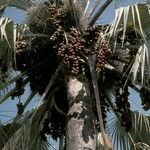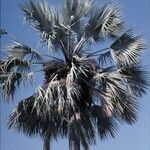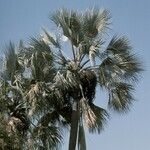Solitary or ? very rarely clustered palm with trunk to 20 m. tall, ± 35 cm. in diameter at breast height, sometimes with a swelling ± 10 m. above the ground, to 50 cm. in diameter, then tapering to the crown; leaves on young trees long-persistent, eventually rotting or being burned to give a clean, grey, vertically cracked trunk, marked with horizontal leaf-scars, above 2.5 cm. apart; crown with ± 20–25 green leaves.. Leaf base broadly sheathing with a central triangular cleft to ± 20 cm. long; petiole 1–1.8 m. long, ± 10 cm. wide at the base, tapering to ± 6 cm. wide near the insertion on the lamina, adaxially channelled near the base, semicircular in cross-section distally, armed with black distally pointing spines along the margins, and scattered black scales, buff hairs and wax; hastula oblique or symmetrical, to 5 mm. high, blackish, usually armed with black spines and abundant buff hairs; lamina costapalmate, with costa curving, to 75 cm. long, with lamina spread of 1.5–1.9 m., usually distinctly folded along the costa, divided to 1/3 or 1/2 the radius into 35–40 segments ± 5 cm. wide, further divided for a short distance at the tip along the abaxial folds; interleaflet filaments prominent; whole lamina glaucous, dotted with small brown-black rounded scales, and with buff scales along the ribs.. Male inflorescence arcuate, 1–1.7 m. long; peduncle ± 7 cm. in diameter at the base, with up to 12 partial inflorescences; lowermost bracts to 1.6 m. long, densely waxy, scaly and hairy when young; partial inflorescences with up to 13 rachillae radiating in a semicircle, moderately stiff, sometimes sinuous; rachillae to 40 cm. long by 1.2 cm. in diameter, with bracts ± 7 mm. wide by 2 mm. high, exposed at anthesis.. Male flower with sepals rather narrow, ± 5 mm. long by 1 mm. wide; corolla stalk ± 3 mm. high, the lobes ovate, ± 4 mm. long by 3 mm. wide; filaments ± 1 mm. long, anthers yellow, ± 1.5 mm. long; pistillode minute.. Pistillate inflorescence arcuate, then pendulous, ± 1–1.25 m. long with up to 10 partial inflorescences, otherwise as the ♂; rachillae rarely more than 3 in each partial inflorescence, often 1 only, to 35 cm. long by 1.3 cm. in diameter, the pits ± 8 mm. wide by 5 mm. long at anthesis, filled with dull reddish-brown hairs.. Pistillate flower with pedicel ± 4 mm. long by 2 mm. wide at anthesis, greatly increasing after fertilization to ± 10 mm. long by 8 mm. wide, including the dense hairs at fruit maturity; sepals ovate, ± 3 mm. long by 3 mm. wide; petals rather narrow, ± 3 mm. long by 2 mm. wide; ovary ± 4 mm. in diameter, green, stigma with nectar drop at anthesis.. Ripe fruit variable, but always ± rounded, obovoid or ovoid, never regularly compressed, cottage-loaf shaped, swollen or warted except for low swellings at the base by the pedicel, rarely with a very slight vertical ridge, and rarely where very close-packed with slight compression marks, ± 5–8 × 5–7 × 5–6 cm.; epicarp very smooth, highly polished, with minute inconspicuous pitting, rich red-brown to chestnut, rather uniformly coloured, rarely with colour flecking, fragile at maturity, easily separating from the mesocarp and its fibres; mesocarp aromatic, ±5–10 mm. thick; endocarp generally conforming to the fruit shape, ± 5–7 mm. thick.. Seed top-shaped, the broad end basal, up to 3.5 cm. high × 3.5 cm. wide; endosperm ± 6 mm. thick.. Fig.3/1,2.
More
A tall usually unbranched palm. The trunk is usually swollen in the middle. It is woody and 15-20 m tall. The crown is made up of fan shaped leaves. The leaves are large and fan shaped and grey-green. They are folded along the centre and deeply divided into fine stiff segments. The leaves are 2 m across. The leaf stalk is 1.3 m long. The leaf stalk has thorns which curve backwards. The bases of the leaflets are unequal. The flowers are of separate sexes on separate trees. The male flowers are produced in short tangled spikes amongst the leaves. The female flowers are larger than the male and have short stalks. The fruit are round and borne in clusters. The fruit can be 4-5 cm across or larger. They have a hard shiny brown shell. The base of the fruit is not narrowed. The fruit have a layer of sweet, edible flesh around a hard bony kernel. The kernel can be soaked then eaten.
Tree up to 18 m high. Stem long, clean, often with a bulge near middle or in upper parts. Leaves fan-shaped, clustered at top of stem. Leaf blade ± 0.6 m across, folded, with many slender segments. Fruit round, hard, shiny, brown.




